Products
LIMS Software - Your Enhanced Laboratory Information Management System
Maximize the efficiency of your laboratory operations with our customizable and adaptable LIMS software. Our LIMS system enhances data management and automates workflows to handle more samples efficiently, accelerate report generation, and propel the growth of your laboratory. With our comprehensive solution, laboratories can manage their data and testing processes seamlessly.
Your All-in-One LIMS Solution: LIMS + ELN + Informatics & More
Labguru integrates a powerful Laboratory Information Management System (LIMS software), Electronic Laboratory Notebook (ELN), and advanced informatics capabilities, making it your ultimate platform for lab operations, data management, and sample tracking. Our LIMS solution ensures compliance and quality management, providing seamless access to data and efficient workflows for your laboratory.
Using the Labguru all-in-one LIMS and ELN system allows you to streamline laboratory operations, improve data management, and increase efficiency, speeding up your research outcomes and saving you time and money. Labguru centralizes all your lab data and sample tracking in one platform, eliminating the need for separate systems for different functions like inventory management, record keeping, and data analysis. This integration ensures regulatory compliance, reduces reliance on multiple vendors, and prevents the loss of invaluable information.
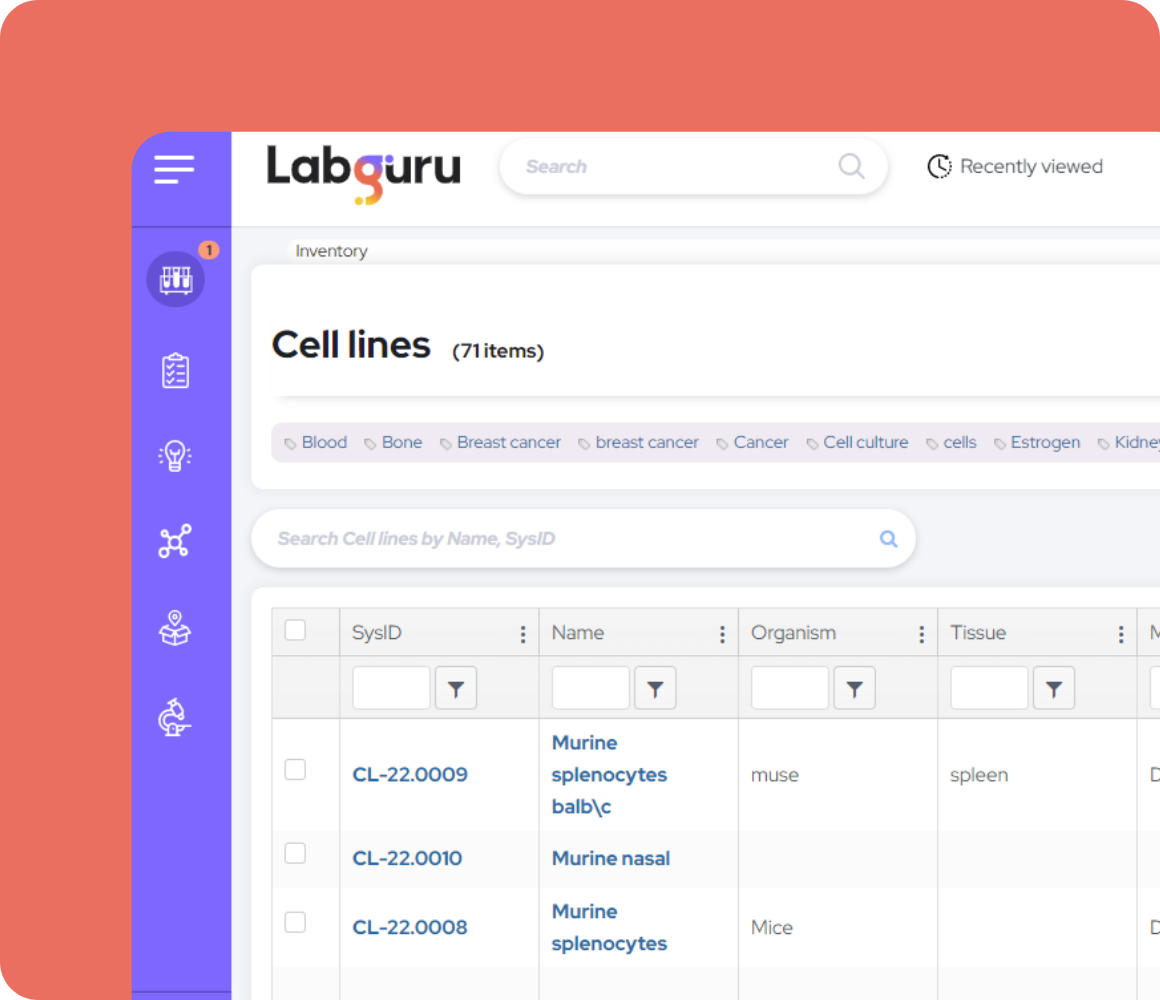
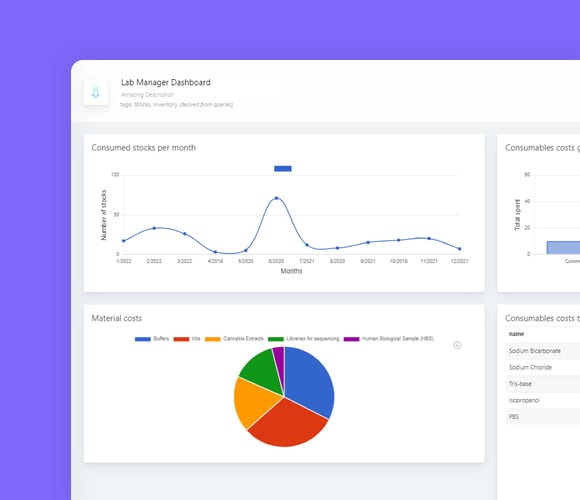
The Labguru LIMS & ELN includes:
- Inventory and sample management - make sure you stay organized and know exactly where everything is located and how much you have in stock
- Workflow automation - transform yourself into a smart lab with automated processes
- Certification analysis - sign and witness or reject experiments
- Reports & analysis - visualize results and perform pre-made or custom queries on data
- Instrument management and orchestration - schedule equipment sessions and track calibration and maintenance
- Big data management - upload and export large amounts of research data
- A rich ELN - manage your projects, experiments, and protocols in one place and access them anytime and anywhere

Key benefits of the Labguru Laboratory Information Management System Software
- Protect your intellectual property
- Share data with your lab members easily
- Enhance data integrity & ensure regulatory compliance
- Derive insights from your research with Labguru's LIMS Dashboards
- Automate repetitive processes and create workflows
- Increase productivity and reduce human errors
- Set high standards of data management
- Easy to use - implement Labguru and begin working immediately
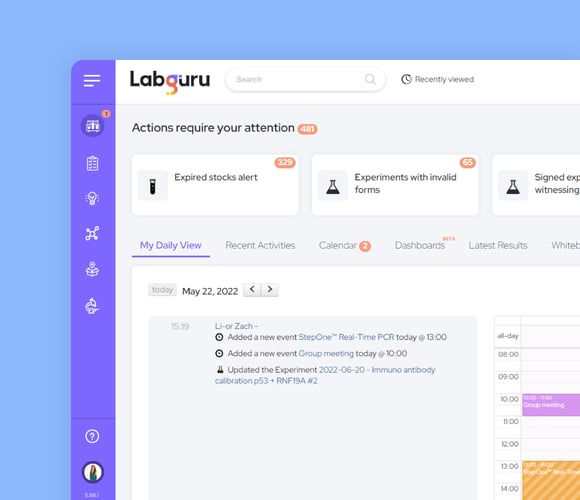

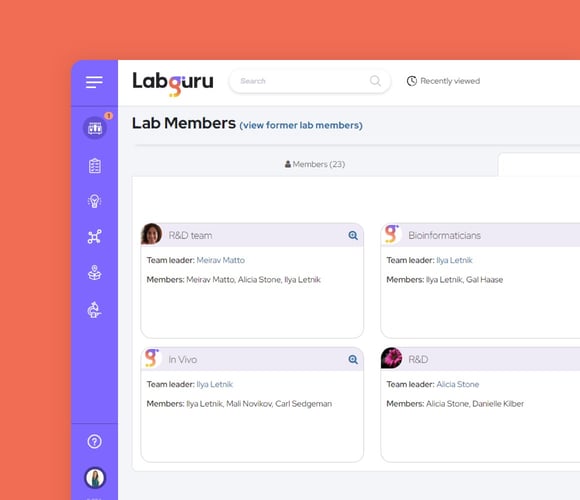
Fast & Simple Implementation
Lossless transition- Labguru ensures a smooth shift from existing laboratory systems and replaces paper lab notebooks with our advanced LIMS software. Our comprehensive implementation solutions provide exceptional support, including training programs and unparalleled assistance, ensuring a seamless integration into your lab's workflows and processes.
Easy to set up—The Labguru LIMS software and ELN system is simple to install in any laboratory. Our dedicated support team of Ph.D. experts will assist you throughout the implementation process, from configuration to managing daily operations, ensuring that your workflows are optimized for maximum efficiency.
Adaptable Implementation Choices - Our LIMS software is highly adaptable, offering customizable solutions to meet your laboratory's unique requirements. Equipped with integrated configuration tools, you can personalize screens, menus, and options, ensuring seamless alignment with your laboratory workflows and data management processes.
Industry-Specific Solutions - Whether you're in pharmaceuticals, environmental science, or academia, Labguru offers tailored LIMS solutions pre-configured with functionalities specific to your industry. These solutions ensure compliance with regulatory standards and enhance data management, providing faster implementation and reduced setup time. This allows your laboratory to focus on what you do best, leveraging our system to manage workflows and processes efficiently.
Specialized Options Available
If you need it, we will create it - we provide customizable LIMS solutions that address specific laboratory requirements, ranging from comprehensive sample tracking and data management to specialized workflow automation and instrument orchestration. Our LIMS system optimizes laboratory processes while eliminating unnecessary complexity, ensuring compliance and enhancing operational efficiency.
Should you have any inquiries regarding the most suitable LIMS solution for your laboratory, feel free to reach out to our approachable support experts. We are ready to assist you in selecting and managing the best system to enhance your lab's workflows and data management processes.
Furthermore, Labguru offers guidance for laboratories in selecting the right LIMS system for specialized applications such as Next-Generation Sequencing (NGS). Our experts ensure that your LIMS solution aligns perfectly with your sequencing needs, facilitating efficient data management, process optimization, and seamless access to critical information, thereby enhancing compliance and research outcomes.
Optimize Lab Resources From Day 1
- Full integration of ELN and LIMS informatics tools
- Lab equipment Calibration management
- Facilitated collaboration within context
- Harnessing of RESTful API to import data from instruments and other resources
- Secure and GXP compliant
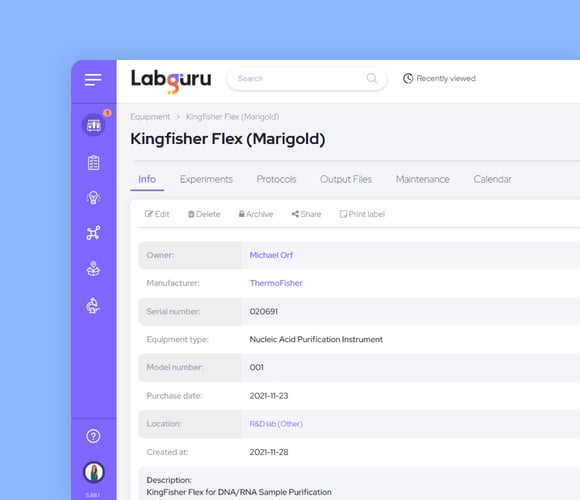

Unparalleled Support
Our application scientist PhDs have worked with both academic laboratories, biotech, pharma, aggritech, foodtech, chemical manufacturing and other types of companies of all sizes. They are here to help you through the process of implementing the Labguru LIMS & ELN system, customizing it to your specific needs, assisting you in managing your lab data and workflows, and ensuring compliance with regulatory standards. Our expert support guarantees that Labguru is fully operational and optimized for your laboratory's success.
A Cutting-Edge LIMS
The Labguru LIMS is the ultimate laboratory information management system solution for companies striving to shorten their time to market, be it biomedical, pharma, biotech, foodtech, manufacturing and more. Our LIMS software enhances data management, streamlines workflows, and ensures regulatory compliance, enabling your laboratory to operate with greater efficiency and manage processes effectively.
LIMS FAQs
-
Laboratory information management system (LIMS) is a software used to manage laboratory samples and workflows, providing an organized, standardized, and centralized system for all lab data, experiments, and workflows.
Unlike the patient-centric LIS, LIMS are sample-centric and most commonly used by research facilities across several industries, including environmental, biotech, pharmaceutical, agricultural, and more.
What is LIMS Software Used For?
The core components of LIMS software include:- Sample Tracking: LIMS tracks samples from the moment they enter the lab until they are disposed of, helping to manage their lifecycle and ensuring accurate inventory management
- Data Management: It stores and organizes large volumes of lab data, enabling quick access and retrieval of results, protocols, and experiment details.
- Workflow Automation: LIMS can automate many repetitive lab processes like sample processing, instrument management, and data analysis. This reduces human error and boosts lab productivity.
- Compliance and Reporting: Labs operate in highly regulated industries, making compliance a big part of day-to-day life. A LIMS helps maintain a proper paper trail by logging all lab activities and movements and turning this into reports. This lets lab managers analyze lab activity at a high-level and makes audits less stressful.
- Inventory Management: It helps track reagents, consumables, and other lab resources, ensuring that stocks of crucial lab components are accurately maintained. This means labs don’t run out of reagents when they need them most, but don’t overstock and waste them either.
- Integration: Most LIMS can integrate with other lab equipment and software, like ELNs, printers, and more so researchers can do all their work within one software.
-
As the volume of samples processed and managed by labs has skyrocketed, manual methods of data management are no longer capable of keeping up with demand. LIMS allows labs to keep up with this increased capacity and processing.
The main benefits include:
Efficiency
An effective LIMS will allow you to automate processes and create agile workflows, meaning laboratories can process samples faster and with greater precision. The standardized system for processing and managing data is designed for efficiency and leaves little room for human error.
Collaboration
LIMS facilitates easier collaboration between researchers and their colleagues by combining all data into a secure, shared Cloud network that offers real-time and up to date information. Additionally, they also allow comments to be left for others within the context of an experiment, improving communication. All in all, it improves visibility across departments and improves researcher efficiency.
Automation
LIMS automations cut down manual data input and reduce human error throughout the sample processing cycle, thereby boosting productivity amongst researchers.
Compliance
With detailed audit trails and end-to-end visibility of disposed samples, a robust LIMS gives users peace of mind that every step in the sample life-cycle is tracked and compliant with regulatory guidelines. -
Choosing the right Laboratory Information Management System (LIMS) is critical to your lab's efficiency and success. Here are the key factors and steps to consider:
Understand Your Lab’s Needs
Start by identifying your lab’s unique requirements, such as:
- Your scientific field (e.g., pharmaceutical, microbiology).
- Lab size and the number of users.
- Whether you need multi-site or multi-language support.
- Areas where automation can improve workflows.
Not all LIMS systems support every function. Determine which features are essential and whether additional costs for add-ons or integrations are acceptable.
Set KPIs and Evaluate ROI
Define measurable goals (Key Performance Indicators) to assess how a LIMS will impact your lab. Common metrics include:
- Time saved on tasks.
- Cost reductions.
- Productivity increases.
Make sure the LIMS you select provides a strong return on investment (ROI).
Cloud-Based or On-Premises?
Decide on the system architecture that suits your needs:
- Cloud-Based LIMS: More cost-effective, flexible, and accessible from anywhere, which is ideal for collaboration.
- On-Premises LIMS: Offers greater security for sensitive data but requires higher costs and physical access for collaboration.
Responsive Customer Support
Select a LIMS provider that acts as a long-term partner, offering reliable customer support for:
- Onboarding and training.
- System customization and scaling.
- Troubleshooting issues to maximize system efficiency.
Request a Demo
Shortlist providers and request demos to:
- Test usability and functionality.
- Ask questions specific to your lab’s needs.
- Learn about upcoming features and special offers.
Plan for Long-Term Growth
Choose a LIMS that accommodates your budget while allowing for future scalability and evolving lab requirements.
By carefully considering these factors, you can select a LIMS that streamlines operations, enhances productivity, and supports your lab’s long-term success. -
A Laboratory Information Management System (LIMS) is crucial for optimizing processes and enhancing efficiency in laboratory environments. The workflow generally involves a sequence of organized steps aimed at effectively managing samples and producing precise data.
Sample Registration
The process starts with sample registration. Upon arrival, a sample is entered into the system with essential details—like sample type, origin, and unique identifiers. This step is vital for maintaining traceability and ensuring compliance.
Sample Tracking
After registration, the LIMS monitors the sample throughout the laboratory workflow. Each step, from preparation to analysis, is documented. This monitoring guarantees that no sample is lost, preserving lab data integrity and efficiency.
Data Entry and Analysis
During sample processing, the data produced from different tests is input into the system. LIMS enables integration with analytical instruments, ensuring smooth data transfer. This minimizes the likelihood of errors commonly linked to manual data entry.
Quality Control
LIMS incorporates integrated quality control checks. As data is gathered, the system automatically validates it against established standards to guarantee accuracy and precision, thereby increasing the lab's data reliability.
Reporting and Results Management
After completing the analysis and quality checks, the system produces detailed reports. These reports are customizable to fit particular needs, offering valuable insights and aiding in informed decision-making.
Data Archival
Once reporting is complete, the LIMS stores data for future reference. This practice ensures adherence to regulatory standards and facilitates audits and evaluations.
In conclusion, a LIMS workflow in a laboratory environment is crafted to improve sample management, increase data precision, and simplify reporting. By unifying these steps into a comprehensive system, laboratories can enhance efficiency and maintain superior quality standards.
-
A Laboratory Information Management System (LIMS) is an essential tool that greatly enhances both the efficiency and profitability of a laboratory. Here’s how:
Enhancing Accuracy and Reproducibility: A LIMS system optimizes data management, ensuring accurate and consistent results. This reliability reduces errors, minimizes costly rework, and bolsters the lab's reputation for dependability.
Improving Operational Efficiency: By automating routine tasks, a LIMS conserves time and labor. Tasks such as data entry, sample tracking, and report generation become quick and error-free, enabling staff to concentrate on higher-value activities that directly boost productivity.
Efficient Data Management: With a LIMS, handling large volumes of data becomes effortless. This system effectively organizes, retrieves, and stores information, speeding up decision-making processes and enabling faster responses to client demands, thereby improving service delivery and customer satisfaction.
Facilitating Compliance and Quality Control: A LIMS assists laboratories in adhering to strict regulations like GMP, FDA 21 CFR Part 11, and GLP. By providing precise documentation and traceability, labs can maintain compliance with ease, avoiding the financial penalties linked to non-compliance.
Incorporating a robust LIMS into laboratory operations enhances its efficiency and profitability, making it a crucial investment for any forward-thinking laboratory aiming for growth and success in a competitive market.
-
Investing in a Laboratory Information Management System (LIMS) can seem daunting, but the potential for substantial savings and efficiency gains makes it a worthy consideration. Here’s how a new LIMS can demonstrate its value to your management team:
Save Time and Boost Productivity
A LIMS streamlines various laboratory processes, which directly equates to time savings:
- Quick Data Retrieval: Reduce the time spent locating and reporting samples with a centralized digital repository.
- Automated Reporting: Effortlessly create certificates of analysis and management reports without human error.
- Sample Handling: Simplify the registration of samples through automation.
- Instrument Integration: Minimize manual data capture by connecting your LIMS to laboratory instruments.
- Accurate Calculations: Automate the calculation of final results to ensure precision.
Minimize Errors and Enhance Efficiency
By automating routine tasks, a LIMS reduces the likelihood of errors, which can be costly both in terms of finances and reputational damage. This efficiency boost is a primary selling point for its implementation.
Tangible Benefits and Financial Justification
To make a compelling case, quantify the tangible benefits. Conduct a cost-benefit analysis that takes into account:
- Operational Savings: Highlight the reduced man-hours and increased throughput.
- Resource Optimization: Showcase how the system can lead to better resource utilization and decreased waste.
- Error Reduction: Outline the cost of errors with current practices and the savings achieved through automation.
Real-life Application
A LIMS isn't just about data management; it aligns with practical laboratory workflows. By mirroring real-life processes, it can seamlessly integrate into your existing operations, ensuring a smoother transition and acceptance by staff.
Equip your management team with these insights to present a concrete financial narrative. By showcasing time savings, improved efficiency, and error reduction, you can illustrate the robust return on investment a new LIMS provides. For further details, delve into comprehensive guides that help outline the financial incentives and strategic advantages in a language that resonates with decision-makers.
-
In the rapidly evolving world of laboratories, ensuring precision and responsibility is essential. A Laboratory Information Management System (LIMS) is vital in meeting these objectives with its strong reporting and audit logging capabilities.Enhancing Accuracy and Accountability
LIMS reporting tools simplify the tracking of samples, tests, and results. This enhances lab efficiency while ensuring data remains consistent and dependable. Comprehensive reports enable lab managers and technicians to make well-informed decisions using precise, current information.
Audit logging, on the other hand, captures every activity within the LIMS. This encompasses alterations to test procedures, instrument usage, and any data modifications. Unlike conventional spreadsheets or manual logs, a LIMS offers a detailed history of changes, ensuring that any discrepancies can be traced back to their source, maintaining traceability and accountability.
Supporting Compliance and Standardization
Audit logs are crucial for laboratories that need to adhere to strict regulatory standards. By keeping a detailed record of all changes and procedures, a LIMS simplifies the process of proving compliance with industry regulations. This degree of accountability assists labs in avoiding expensive fines and penalties.
Moreover, by standardizing workflows and procedures with detailed logging, consistency is maintained across different lab operations. This results in better process control minimizes errors, and ensures that all staff follow the same protocols.
Facilitating Seamless Data Integration
Instruments can be seamlessly connected to the LIMS, automating data collection and ensuring logs accurately record usage details. This integration ensures that instruments are properly calibrated and handled by qualified staff.
Moving Towards a Paperless Environment
A major benefit of implementing reporting and audit logging in a LIMS is the shift towards a paperless laboratory. By converting records and logs into digital formats, labs can decrease the clutter and mistakes linked to paper-based systems, promoting a more sustainable and efficient work environment.
To sum up, the reporting and audit logging features of a LIMS offer significant advantages by maintaining data integrity, facilitating regulatory compliance, and boosting operational efficiency. These capabilities are essential for any laboratory striving to remain competitive and dependable in the industry.
-
Choosing an appropriate Laboratory Information Management System (LIMS) is essential for the efficient and effective operation of your laboratory. Several considerations must be taken into account when deciding whether to develop a LIMS internally or select a commercial solution.
1. Customizability and Flexibility
Your LIMS should enable thorough sample management, encompassing the entire lifecycle of a sample, from collection and storage to analysis and reporting. It is essential for the system to support biobanks, manage stability studies, and address specific logistical requirements, such as chain of custody.
2. Comprehensive Sample Management
Your LIMS should facilitate comprehensive sample management. This includes tracking the entire lifecycle of a sample, from collection and storage to analysis and reporting. It’s crucial for the system to support biobanks, manage stability studies, and handle specific logistic needs, such as chain of custody.
3. User-Friendly Interface with Secure Access
Your LIMS should enable thorough sample management, encompassing the entire lifecycle of a sample, from collection and storage to analysis and reporting. The system needs to support biobanks, manage stability studies, and address specific logistical requirements, such as chain of custody.
4. Seamless Third-Party Integration
A key consideration is the system’s ability to integrate seamlessly with various instruments and third-party software. This flexibility is vital to maintaining efficiency and ensuring all data flows smoothly between systems without manual intervention.
5. Operational Efficiency and Quality Assurance
The optimal LIMS should improve laboratory efficiency by establishing streamlined workflows that automate routine processes. This not only allows personnel to concentrate on critical tasks but also guarantees the delivery of high-quality, traceable results that meet customer expectations.
When assessing your options, these factors can guide you toward a solution that aligns with both your current needs and future objectives. By concentrating on these key areas, you ensure your laboratory is equipped with a LIMS that enhances productivity, compliance, and data integrity.
-
Who Typically Uses LIMS Software in Laboratories?
In laboratory environments, the key stakeholders of a Laboratory Information Management System (LIMS) are typically those who have a vested interest in the efficient and accurate management of laboratory data and processes. These stakeholders include:
-
Laboratory Managers: They oversee the overall operations and ensure that the LIMS aligns with the lab's strategic goals and regulatory requirements.
-
IT Professionals: Responsible for the technical implementation and maintenance of the LIMS, ensuring it integrates smoothly with other systems and remains secure.
-
Regulatory Compliance Officers: They ensure that the LIMS supports compliance with industry standards and legal regulations, which is crucial for maintaining certifications and avoiding legal issues.
-
Financial Officers: Interested in the cost-effectiveness and return on investment of the LIMS, they monitor its impact on the lab's budget and financial performance.
-
End Users (Technicians and Scientists): As primary users, they provide feedback on the system's usability and functionality, influencing future updates and improvements.
These stakeholders collaborate to ensure that the LIMS effectively supports the laboratory's objectives, enhances productivity, and maintains high standards of data integrity and compliance.
-


